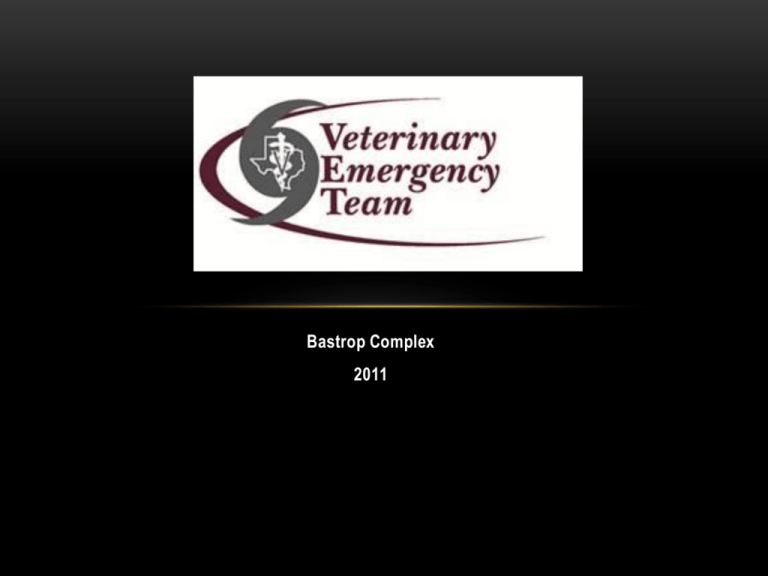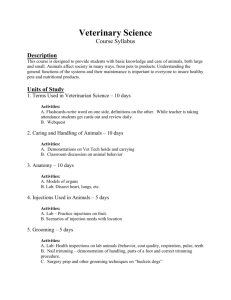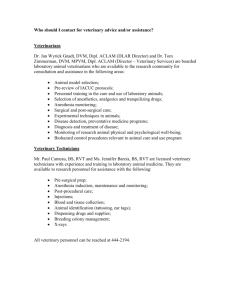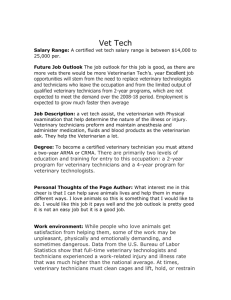the ppt associated with this video - PEER
advertisement

Bastrop Complex 2011 VETERINARY EMERGENCY TEAM (V.E.T.) HISTORY The Texas A&M University College of Veterinary Medicine and Biomedical Sciences has been an active participant in assisting the citizens and animals of the State of Texas in times of emergency. Hurricanes Katrina and Rita Large animal patients were evacuated to alternative College facilities and we became a HUMAN Surge Hospital for over 300 Human patients Faculty, staff, and students played a critical role in: • Animal patient evacuations • Meeting the needs of our human patients Delivering (and sometimes feeding) meals Assisting human medical staff with patient care Overall attending to the needs of evacuees • Returning the Large Animal Hospital back to an operating Veterinary Referral and Teaching Hospital KATRINA AND RITA • Small Animal Clinical Sciences oversaw the small animal evacuation center in conjunction with Brazos County officials • VMTH continued to provide small animal veterinary medical care • Large Animal Clinical Sciences developed an alternative location to provide triage and evacuation of large animals at a private off-site location. GUSTOV AND IKE • Large Animal Clinical Sciences faculty and staff, along with Brazos County officials, established a large animal evacuation center at the Brazos County Expo Center Received about 200 large animals primarily from the Galveston area • Landmark event Implementation of a large animal shelter plan Official inclusion of veterinary students into our emergency response efforts Provided triage and monitoring of large animal evacuees Viewed as an over-whelming success by animal owners who evacuated to Brazos and surrounding counties Provided an educational opportunity for students which leads to an increased number of veterinarians in our state who are well versed in emergency response PRELIMINARY REQUIREMENTS BEFORE DEPLOYMENT • All veterinarians, technicians, and staff had to take ICS (Incident Command System) Emergency Management training. • ICS 100, 200, 700, and 800 • Additional non-required training: ICS 300 and 400 • Entire team had to declare availability to deploy and make personal arrangements for family and animals. • Our support had to be officially requested by either the County Judge, Texas Animal Health Commission, OR Texas Task Force One (TTF-1). • Our official deployment mission was to support the TTF-1 Service Dogs and Handlers. • Care of effected animals from the wildfire was a secondary mission that developed after deployment. WHO? • Veterinarians • Technicians • Staff • Students A MELTING POT • Each individual deployed with the unit brought specialized skills that were beneficial during the deployment. • Small and Large Animal Veterinarians, Technicians, and Students assisted and helped each other with a variety of tasks that needed to be accomplished on each day. We each had something to add or contribute which allowed us to function as a well oiled machine. TECHNICIANS • Carin Ponder, RVT • Graduated Tomball College with AAS in Veterinary Technology in 1998 • Private practice experience with small and large animals, exotics, and wildlife from 1998 – 2004 • Came to Texas A&M College of Veterinary Medicine in 2004 • Anesthesia Service 2004-2008 • Small Animal Clinical Services 2008 - present Carin Ponder, RVT Carin’s broad spectrum of knowledge of different species, including wildlife, helped the team deal with wildlife issues when they presented themselves. Anesthesia is her specialty, so Carin was at ease sedating and anesthetizing animals that needed further chemical restraint so the team could treat them. TECHNICIANS • Dana Whitaker, RVT • Graduated Bel-Rea with AAS in Veterinary Technology in 2005 • Second career • Came to Texas A&M College of Veterinary Medicine in 2005 • Anesthesia Service 2005 - 2007 • Small Animal Soft Tissue 2007 - present Dana Whitaker, RVT As a soft tissue technician, Dana was our expert wound tech as well as an expert at bandaging TTF1 Dogs and burn patients. TECHNICIANS • Lessa Block • Graduated Angelo State University in 2003 with a BA in Animal Science • Came to Texas A&M College of Veterinary Medicine in 2003 • Small Animal ICU 2003 - present • EMT certification in 2010 Lessa Block, RVT As an Small Animal ICU technician, Lessa was our drug calculator since she is able to recall dosages quickly off the top of her head. Lessa is also extremely proficient at IV catheter placement and wound bandaging. TECHNICIANS • Melissa Welch • College Hours at Blinn and Texas Tech • Private practice experience with small and large animals from 1986 – 2001 • Came to Texas A&M College of Veterinary Medicine in 2001 • Equine Internal Medicine 2001-2008 • Food Animal Medicine 2008 - present Melissa Welch As a former Equine Internal Medicine tech and a Food Animal Medicine tech, Melissa was able to lend assistance when dealing with hoof stock of all sorts. Her private practice experience was invaluable in assisting with the numerous small animals that were seen. TEXAS TASK FORCE 1 • Texas Task Force 1 (TTF-1) is an Urban Search and Rescue response team. • Represents numerous fire departments and organizations throughout the state. • Multi-disciplinary: Search, Rescue, Medical, and HazMat/WMD. VET TEAM • As our first deployment, we did not know what to expect or what would be expected of us. It was an evolving learning experience and each day was different. • We were surprised about the abundance of feline patients compared to canine or large animals. VET TEAM • We learned that it is far better to take everything we think we’ll need and send back the surplus, than to not take everything and have to make multiple trips back to A&M to become fully functioning. • Very first day we needed surgical supplies and did not have any. COMMUNICATION/MEDIA • Was/Is an extremely useful tool in spreading the word regarding: • the status of the fire • locations of human and animal evacuation sites • the rescue and relocation of animals. The VET Team and the TTF-1 SAR Dogs Our primary mission was to ensure the health and safety of the TTF-1 Dogs. Concerns included dehydration, pad injuries related to crawling over “rubble”, and pad burns due to walking through smoldering and hot ash. Dehydration was addressed twice a day by administering subcutaneous or intravenous fluids. Handlers also made sure to take water breaks for the dogs by carrying collapsible bowls and water bottles. Pad injuries were a serious concern due to the catastrophic damage that had occurred at the majority of the properties searched. Homes were often unrecognizable and countless hazards existed hidden, buried beneath inches of hot ash. On the first day, a SAR dog lacerated their pad on a searing hot piece of metal. Fortunately, the heat from the metal cauterized the severed vessels and the handler was able to protect the foot with a bandage until he was able to return to the VET team, where we sutured the laceration closed. Due to the environment the dogs were working in (hidden hazards and hot ash), it was decided to have each dog wear a set of booties to protect their feet from lacerations and burns. Every morning, the VET Team would wrap the dogs’ feet during their fluid therapy to protect them for the day. How animals were identified and rescued: 1. TTF-1 SAR or concerned home owners would identify locations of known animals to the sheriff and/or animal control. 2. Animal control would dispatch a truck to rescue animals identified and any animals seen while en-route. 3. Animal Control would return to the forward operating base camp for the VET team to triage wounded and dehydrated animals. 4. Once treated and recovered from sedation or anesthesia, Animal Control would transport the injured animals to the Austin Humane Society and the uninjured to the Bastrop Animal Shelter. 5. Once at the Austin Humane Society, they took pictures of every animal brought in through animal control INCLUDING taking pictures in Bastrop. 6. Every single picture was placed in an album on Facebook for owners to locate and identify. 7. Once identified, each heartwarming reunion was photographed and placed in an album on Facebook as well. The Austin Humane Society successfully reunited OVER 240 animals effected by the Bastrop Complex Fire. They also aided the healing process of the homeowners who had lost everything except their pets and the healing of first responders as we got to witness these wonderful happy reunions for these animals and their owners. It is our hope that in future natural disasters that communities look to Austin and follow in their footsteps by honoring the human and animal bond by working collectively with law enforcement and veterinary relief as well as utilizing mass communication resources. HOW CAN I HELP? The VET Team is funded through grants and donations from corporations, government, and private individuals. Donations can be made online at: http://vetmed.tamu.edu/giving/opportunities/veterinary-emergency-response-team ANY QUESTIONS?






